
Each illustration of a beard originally faced the beard’s description. These have been moved to follow the title of the type of beard.
Footnotes have been moved to the end of the paragraph to which they refer.
Variant spelling and inconsistent hyphenation are retained.
Minor changes have been made to make punctuation consistent.

With respectful affection to the illustrious memory of Shagpat, the son of Shimpoor, the son of Shoolpi, the son of Shullum.
BEAVER
BY
JOHN KETTELWELL
An Alphabet of typical Specimens, together with Notes and a terminal Essay on the Manners and Customs of Beavering Men
LONDON:
T. WERNER LAURIE, LTD.
30, NEW BRIDGE STREET, E.C. 4
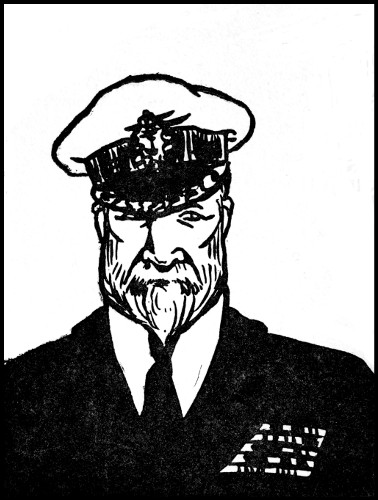
The specimen mounted is typical and the coat is good, harsh and not silky, a common fault in these rough-haired examples.
An Admiral-King-Beaver is unthinkable ... “derogation of God’s honour,” etc.
Though the sport is deservedly popular in the Service, it is attended by infinite risk should the specimen be of higher rank than the players. K. R. and A. I. contain no definite ruling as to the legality or otherwise of the game, but a Court-Martial would probably trip an unlucky player on “conduct to the prejudice,” etc.
In civil life (and plain clothes) it is most unusual to be able to score these specimens, hence the different values of Rear-Admirals, Vice-Admirals, etc., is not given, nor those of the various branches of the Service, Executive, Engineer, and the like.
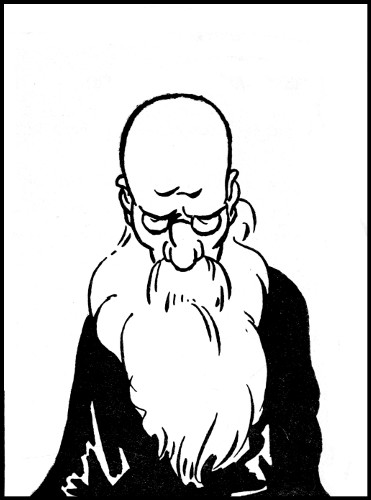
That depicted is a magnificent specimen in full winter-coat.
They are not common, but occur frequently—the apparent paradox is explained by the fact that they are usually of an extremely retiring nature, and reside by choice in coigns and nooks.
For a specimen such as that mounted game should be claimed and nothing under three points accepted; rather call off the match and communicate with the Association.
In scoring really fine specimens in full winter-coat extra points can, and should be, claimed for purity of tint, bushiness, etc.

There is no record of a specimen being scored. Probably the last person to do so may have been Jason. The best authorities assume this, adducing as contributory evidence his later, passionate quest of the Golden Fleece. Ourselves we regard it as more likely that Chiron was never scored, Jason being held back by the natural delicacy of one in statu pupillari. In fact, Chiron was, almost certainly, a “local double-fault.”
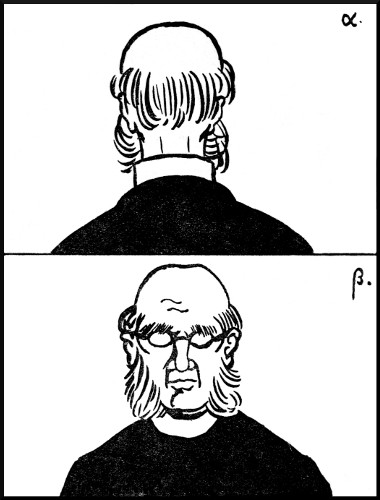
This question is dealt with in the terminal essay.
The specimen is a good one, and no player who is deceived by a growth of this kind need feel the smallest depression. It is the kind of thing that might happen to anyone.
A young specimen, darker than dark brindle, has, I believe, never been scored.
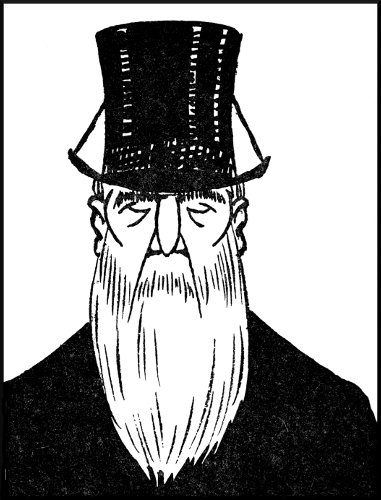
Rare in general, there are frequently to be found in Cathedral cities large coveys, not very strong on the wing.
Local rules should be consulted as to the scoring. Fine specimens count at least three points.
I myself, recently, claimed an Ecclesiastical-King, in a country town, and was awarded two games for it; a well-known local rarity of which the place is justly proud.
It was a superb specimen, in good coat, a darkish brindle, and in official robes.
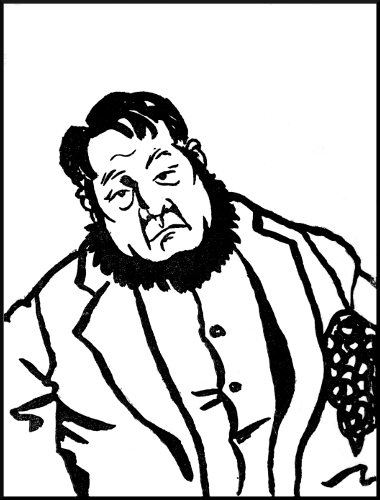
The species is less common than formerly. Some purists refuse to score these Fringed-Georgics on the plea that the upper lip is bare and the chin partially bare and that they are, therefore, double-faults. The general ruling is that as the adornment circumnavigates the face the chin is not bare, the bareness of the upper lip is immaterial and the specimen should be scored; one point in the country, three points in London.
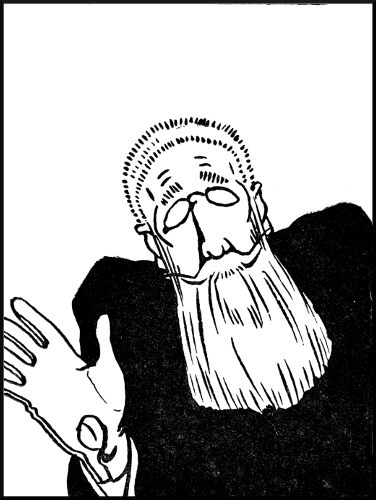
The game is almost unplayable in France. Owing to the superabundance of specimens only rarities should be scored.
A report has just been received from Cap D’Antibes of a “magnificent Wasp-Waisted-King.” Game was called. No information was sent (correspondents are deplorably slack) as to colour or coat.
Good players, in France, lay great stress on minute differences in colour and characteristic, i.e., crimped, curled, waved, rat-tail, wuzzy, wild-garden, etc.
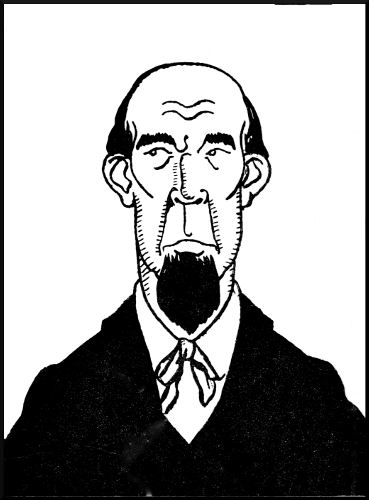
These delightful specimens are now, unhappily, becoming very rare.
They are still occasionally scored in the neighbourhood of places of worship and on the seashore.
Some claim increased points in ratio to the length of the upper lip.
The specimen mounted (Stockton-on-Tees, 1919), is a fine one, exhibiting all the marked features of the genus, including a most gratifying labial expanse.
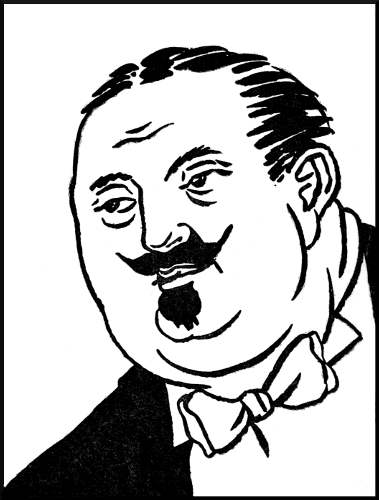
Not common in England; when scored in this country are almost invariably migrants.
These amusing specimens are, curiously enough, commoner in winter-coat than in ordinary plumage.
There are no tricks about scoring an Imperial. Any specimen with moustache and a growth beneath the lower lip, of which the parent area does not extend to the lower edge of the chin, is an Imperial.
Score three points for a Full-Black; one point for a White.
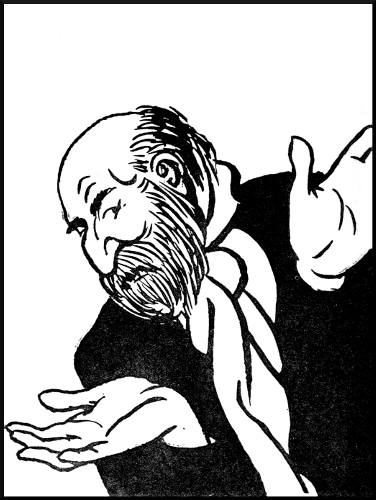
These exotics are fairly common, and local sportsmen can be relied upon to flush a few on short notice, provided that they are allowed to choose the beat.
In many ways curiously attractive, the charm of the species is marred by the frequent lack of neatness of plumage; as a race they incline to landscape-gardening with their hirsuteness.
Carefully note their musical cry of “Oy-Yoy ... Oy Yoy.” A specimen in full song, when the moon is full, counts game.
Some experts have a very nice scale—by which they score—of the curvilinear bill. This is a pretty point and a pleasant raffinement, but too subtle for the ordinary week-end player. Of course any unusually fine frontal curve should be claimed and scored as a rarity.
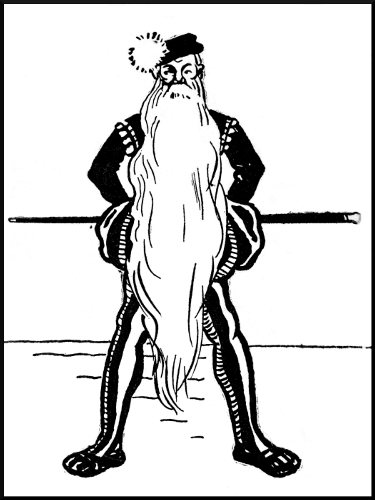
This specimen is mounted for instructional purposes only. Connoisseurs and collectors are, of course, entirely au fait with the deliciousness of this gorgeous creature.
George Killingworth, in the year 1555, was sent to the court of Ivan the Terrible (one of the many monarchs who have, from time to time, taxed Beavers) as the agent of Queen Mary. His beard was five feet two inches in length and it was yellow. He was without doubt the most flawless specimen of a Yellow-King ever seen.
It is considered in the highest degree unlikely that anything approaching this efflorescence will be noted nowadays, hence no score is suggested.
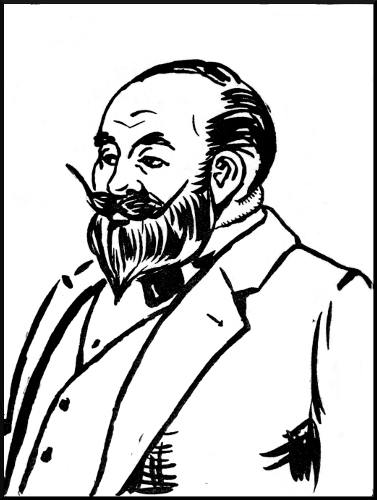
It is worthy of remark in passing that this distinguishing title is due to the genius of a child—“trailing clouds,” etc.—who, on observing the first specimen ever scored, cried, “Oh, look; he’s licked it.”
The species is very rare. Off-shoots of the old stock, in the form of Semi-Walruses, are occasionally observed, but the Licked-Beaver is generally regarded as almost extinct. Possibly the cause of this diminution, if not extinction, may be the increase in the cost of living.
The specimen mounted is a very fine one. Should a player have the good fortune to score a Licked-Beaver, let him remember that it is the density of the licking, the spear-form, the sharpness, that should be regarded rather than the length of the portion licked.
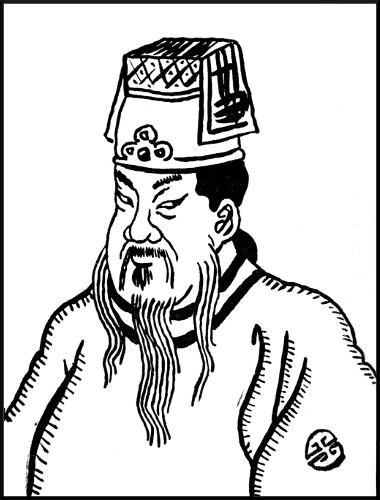
Even in plain clothes should score two games if seen in England. There is no ruling as to the points to be scored if observed in this country in full plumage.
This specimen is often wrongly catalogued in books of reference as a Mandarin-King-Beaver. Royalty or Kinghood is impossible for a species which supports a very notable gap between its central adornment and the maxillary-fringes.
The specimen mounted is, so to say, traditional, that is, it is a transcript of an early-nineteenth century Chinese brush-drawing on silk in Chinese ink representing a hero, or as we should say, a Beaver.
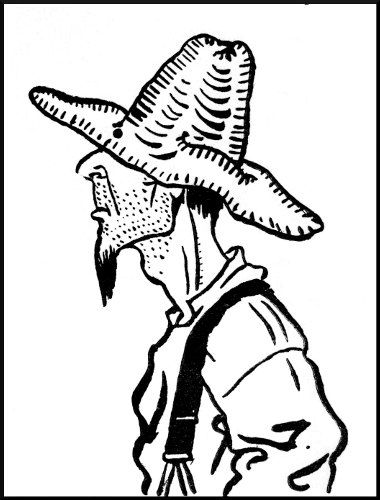
Really good specimens are very rare. They are reported to flourish in the Eastern farming states of the United States of America, but British research is lamentably behindhand, and our exact knowledge is quite fragmentary.
In any case there is one simple rule for the guidance of the amateur; no Nanny-Beaver can be claimed or scored of which the adornment does not depend a full two inches from the under-surface of the chin.
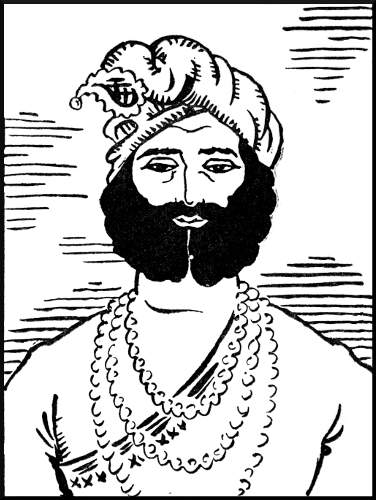
These strangely beautiful specimens are rarely seen in this cold country.
Those who have had the privilege of observing closely a gaggle of Orientals in indigenous plumage (the species is pathetically subject to local changes) will, assuredly, ever prize the recollection.
The most noteworthy feature, apart from the extraordinarily fine quality of coat (glossiness, sheen, etc.), is the exotic parting which lends a wistful charm to the otherwise opulent glories of these occasional visitors.
Score always two games (in England); set, if the specimen is in indigenous plumage.
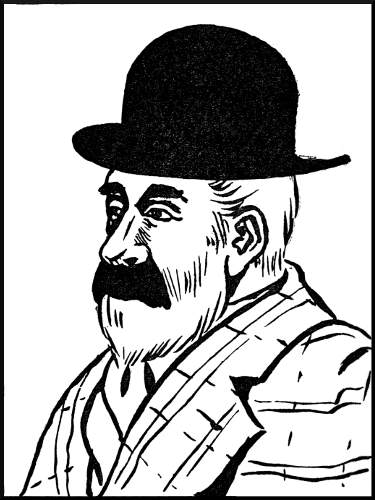
These specimens are curiously attractive and are more often scored than one would think. Artists, above all others, wax well-nigh lyrical over the beauties of a well-defined Parti-Colour, one, that is, in which there is almost no shading, the black being black and the white, white. The same colouration is observed in the pelt of the Colobus monkey and justly admired.
It is not possible to distinguish between natural and artificial Parti-Colours, unless one should happen to be a relative of the specimen. All Parti-Colours are, therefore, scored. (Two points.)
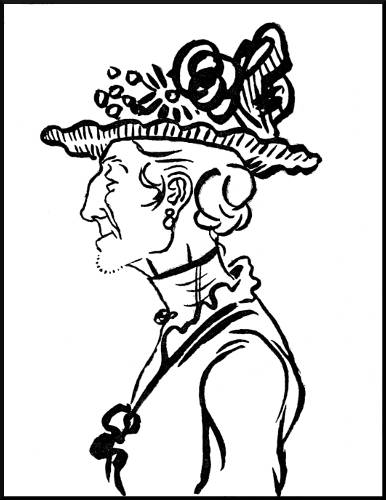
It has been objected that it is not gallant to score these undoubted rarities. Theoretically it is, certainly, not pretty conduct, but, on the other hand, all is fair in love and war, and ... has any man ever refused to shoot a rhinoceros on the plea that it was a female? (I merely ask ... someone may have done so. There may even be a close time for doe-rhinoes.) Be that as it may, the scoring of Queens is an affair of lineage. Regard this eighteenth century distich:—
Queens are always scored extravagantly. Usually game; extra-rarities two games, and so on. The Pink-Queen is, without doubt, the rarest of her kind; conversely, when found, she is usually a superb specimen, in rich coat. The question of Queens is dealt with broadly in the terminal essay.
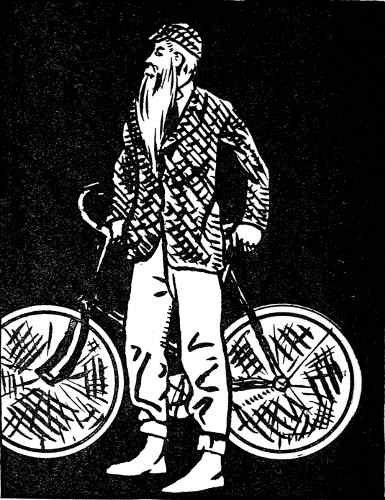
I feel a very natural emotion on commenting on the sublime specimen of the Red-King, the ultimate hope of every keen collector, which is portrayed on the opposite page. Observed outside “The Goose and Gridiron,” in Slogsby-under-Hill, this noble creature deprived both my companion (an ex-local champion) and myself of speech for three minutes.
Had he been carrying a ladder (the ne-plus-ultra of Beaverhood) we had never recovered from the glory of the revelation.
Red-Kings score “Game, set, match.” A Red-King on a green bicycle, carrying a lanthorn (or lantern), scores do. do. “Local Championship.” A Red-King on a green bicycle carrying a ladder (poor old Pelion!) has never, alas! been reported up to the present.
There are dreams of scoring a Red-King, complete with fitments, on a High Bicycle ... all things are possible, even a ravishment such as that.
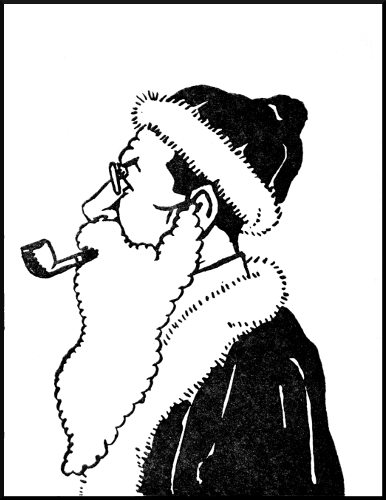
These are usually scored, though your conscientious expert demurs at so doing, as it has been held—and the view is well supported by players of repute—that they are strictly-speaking Double-Faults, the adornment being temporary.
The genuine Santa-King-Beaver, complete with reindeer, sleigh and business with chimney, has never, I believe, been scored.
Claim a game if you, a stranger adult, score one.
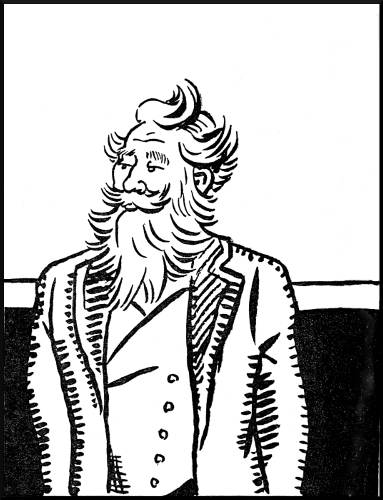
It may, perhaps, be thought that this is a fanciful, a pernickety differentiation—such are to be deplored—but there is a very distinct species of Beaver—King or ordinary—having these marked characteristics, and the best players invariably claim a Tufted, and two points, if they have the luck to espy a specimen such as that depicted.
The points to look for are the three patches of foliage in centre forehead and over either ear. The chin-growth partakes of the nature of these, but it is the tufted temple which makes your rarity.
In the last century this sub-branch of the genus Longi-Florum was fairly common; sub-title, Adolphus.
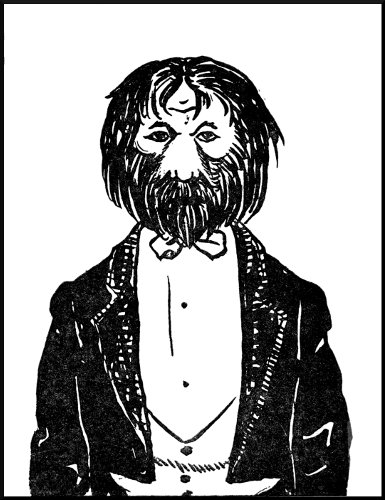
The specimen mounted is, I believe, unique. A noted scientist in private life, in public life an exquisite Ursine—or (as some say) Leonine—there are no data extant to assist us in forming an opinion as to why he did it.
It is scarcely likely that this phenomenon will flower again for centuries. Should a pale reflection be observed, remember that the salient points are: (a.) great width across the cheek-bones, (b.) uniformity of foliage.
The miracle mounted opposite had tendrils, delicate, wonderful, almost on the lower edge of the eye-lids.
The osseous formation of the nasal promonotory should be carefully studied by earnest amateurs.
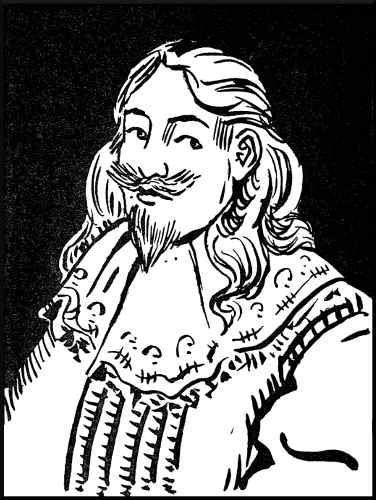
Mounted as an historical curiosity: they are now extinct.
In full bloom they were, I am told, very beautiful. The finest specimens had never shaved, hence the coat was a miracle of gloss, softness, shimmer and silk.
Should anything, anything approaching this shape be observed, kindly write at once to the Association, who are only too anxious to catalogue every rarity.
Disregard cropped hair. One dare not hope for a modern specimen in trailing-coat.
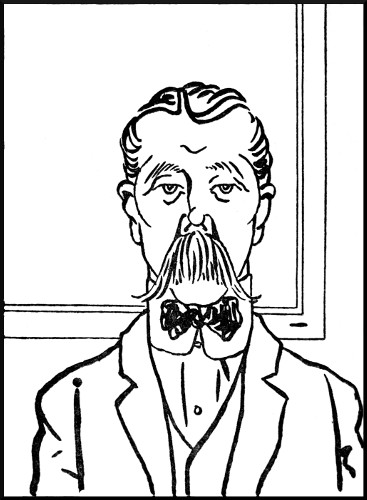
These cannot be scored when playing Beaver.
A debased form of the game called “Walrus” is—actually—played, and, occasionally, mixed Walrus and Beaver. The Walrus game usually ends in an unseemly wrangle, owing to the intense difficulty in deciding on the exact status of the specimen.
The specimen mounted is almost perfect—perhaps it is a thought regular—it was observed in 1922 in Knightsbridge; the neat bow-tie was pale blue satin, almost certainly attached by a brass clip.
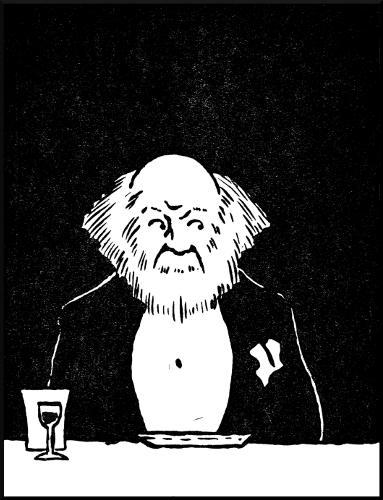
These specimens are only scored by specialists.
There is a perfectly distinct difference between a Xanthine, a Red and a Yellow, but it is very small, and to mark it requires a very nicely-trained eye. Xanthines are usually rather bewildered-looking, and are remarkable, in general, for profusion of crop and coarseness of coat.
The habit of insisting on minute colour-niceties is to be deplored as tending to debase the sport to the level of the philatelist’s “rose-red on carmine,” “carmine on rose-red.”
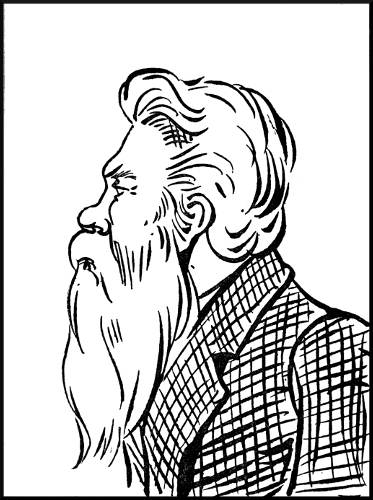
Excessively rare.
With the exception of George Killingworth, cited on page 25, the most notable Yellow-King of whom we have record is Leo Vincey, the superlative Beaver who went, in company with his dark-brindle guardian, Mr. Holly, in search of “She” ... or should it be “Her”?
There is no record in office of a Yellow-King having been scored in the last eleven years. They are seen occasionally in France, and there are vague rumours that a certain number are bagged yearly in Germany.
Claim extravagant points if you have the fortune to light upon one. Here again sheen is most important, and the coat should be fine, soft and silky.
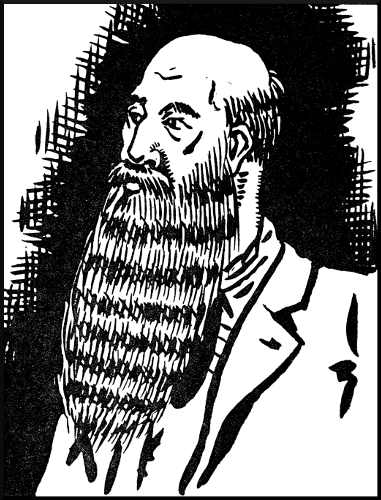
Excessively rare.
I, myself, have once scored a Zebra-King, but it was, and is, the only specimen of which I have heard, and it is greatly prized locally.
The colour-demarcation must be very obvious before one can claim a Zebra. There is as much difference between a Yellow and a Red-King as there is between a Zebra and a Brindle.
The King illustrated is—I speak without fear of being contradicted—literally unique. In superb coat, ideal shape of attachment, in colour—a greenish tabby with dark markings, the Zebra I have the pleasure of showing you represents the ne-plus-ultra of rarity.
He thus forms a fitting, as it were, cul-de-lampe to my “littel” guide.
Adam, according to tradition, was created in full King-Beaverhood, and, burgeoning amid the bougainvillea and borage of the Garden of Eden, the Beard, throughout the centuries, has bloomed and faded, resurged, again faded, then blossomed anew that, in the fullness of time, the Beard-Bearer might be crowned with the honourable title of Beaver. “The soft susurrus of his silken stride” brings joy to the heart of man, perhaps also “game, set, match,” and the shape, the colour, the texture of his adornment provoke a fastidious scrutiny akin to that of a connoisseur appraising a Crown Derby figurine. For many years the auburn-haired hero who grew a beard was not, ipso facto, a person of any importance. A dignitary of the Church, whose venerable features were complemented or obscured by a snowy, a grizzled or a brindled beard of majestic length, was not, inherently, remarkable. Behold them now, a Red-King and an Ecclesiastical King, cynosures, orchids upon the unlovely tree-trunk of our common life. As the poet might have written:—
The celebrated Beavers of history need not be catalogued at length. Shakespeare was a Bald-Beaver, apparently an Anticipatory-Vandyke. Napoleon Bonaparte was not a Beaver. Julius Cæsar, Edward Gibbon, Sir Joshua Reynolds, Alexander VI. and Beethoven did all “... against the edicts of God, the oracles of the Prophets, the placits of councils and the judgment of learned men, hold fast the foolish custom of shaving.”[2] Contrariwise, [Pg 57]Hannibal, William Morris, Rodin, St. Paul and Juan Rodriguez de Silva y Vélasquez were all content with “nourishing their horrid bushes of vanity.”[3] The Jews bore their beards proudly from out the Captivity. Indeed they took captivity captive; did not the Egyptians from time to time, asserting their masculinity, assume ceremonial false beards, “double faults” to a man? The most antient Romans were King-Beavers; the Normans were Walruses; the Greeks supported a considerable number of King-Beavers, among them Pericles and Socrates, “shaving was very rare in the early part of our period (440 B.C.–330 B.C.).”[4] Until the eighteenth century Beaverhood was common, since that time it has grown rarer and rarer, with a sudden uprush of fur to the face in the middle of the last century, an uprush which has now almost died away. We read “... the value of their fur has caused their destruction in great measure where they were once numerous, and has led to their extirpation where there is evidence that they existed as a not uncommon animal. They were formerly distributed over the greater part of Europe. In England semi-fossilised remains show that they were not uncommon ... in 1188 Giraldus stated that they were living on the river Teify in Cardiganshire ... some were known to frequent the Elbe in 1878.”[5]
The origin of the game, which is scored in exactly the same manner as Lawn Tennis, is unknown. There are, however, various theories; one school holds that it came to birth in Oxford, another that it emerged in the other place, and a third traces it to Malta [Pg 58](where “my brother from Gozo” was, doubtless, a local champion) and seeks for some association with antient mysteries.
The outlines of the game itself are so simple and well-defined that the question of rules scarcely arises. A bearded man is a Beaver, claim him, crying aloud, as musically as possible, “Beaver, fifteen love”—or appropriately to the score. If both players cry aloud simultaneously it is a “no-ball.”
The system of “double faults” deserves explanation. The educational value of the game is high, fostering as it does quickness of observation and that desirable attribute, an eagle-glance. When a player has had some little practice he will often score winning points from behind the specimen. Thus a side-whiskered gentleman may be claimed from the rear but, on drawing level with the quarry, it is observed that the chin is bare ... double fault.
“Local double faults” are always a matter of courtesy, and if one claims a “local D. F.” one is not mulcted in the point. Usually it is some revered and Friend-of-all-the-World Beaver who is created, by general consent, a “local D. F.,” to enable players to discuss, unembarrassed, the day’s sport with him. Juvenile players find this convention of the greatest possible service. Hot-tempered, hard-handed uncles and such like are swiftly appeased by being made “local D. F.s,” and join whole-heartedly in the triumph occasioned by the capture of some other Brindled-King.
It has been mentioned in the notes that very high standards have been from time to time set up as regards the status of Beaver. Passionate purists have, indeed, claimed that the charming Half-Beaver is a D. F., that the delicate wilding, the Fringed-[Pg 59]Georgic, is a D. F., even that the Imperial and the Nanny are suspect. Heed not such persons. Remember Knut and Mrs. Partington, nor seek to gild the lily. The sign manual of the Beaver is the not-naked chin, ἂγυμνος. No one of the specimens mentioned above has a naked chin, therefore, they are all Beavers; quod erat demonstrandum.
The game can be played anywhere, except in Burithabeth, for “these men have no beards at all, for we saw them carry a certain iron instrument in their hands wherewith, if any hairs grow upon their chin, they presently pluck them out.”[6] Cathedral cities are a favourite habitat of the genus, and some are always to be found in the neighbourhood of Pall Mall. Dockyard towns provide large numbers of the ordinary variety, but very few Kings.
It is not generally known that a rigidly conscientious person can play single-handed Beaver with great content. One scores Beavers walking in the same direction as oneself to the server, Beavers coming from that direction, and so passing the player, to the striker and stationary Beavers in accordance with the direction in which their heads are turned, towards or away from the player. Beavers debouching suddenly from cross-roads, if one has not time, as on a swift omnibus, to observe their ultimate direction, are “no-balls.”
It has been objected that the game is nonsensical, anti-social and essentially discourteous. Nonsensical it is, an it please you; but is not nonsense a rare and a precious thing? Is not the nonsense of Lewis Carroll quite entirely adorable? Is not Lear’s story of Violet, Slingsby, Guy and Lionel a thing of impres[Pg 60]sive beauty? The game is not anti-social, for it entails an increased interest in and admiration of one’s fellow-men and, as regards discourtesy, surely it is as much a compliment to a Red-King to cry on him, “Beaver, game, set, match,” as it is to comment upon some damsel’s handsome eyes.
“Aristotle in his ethics takes up the conceit of the Bever,”[7] and, in general, one may assume that the bearded are proud of their adornments, love them, cherish them, even going so far in some cases as to enclose them in silken bags before retiring to rest. Controversy has long raged as to the propriety or otherwise of shaving. The Greek Church held strong views on the point, “... and also they say, that we sin deadly in shaving our beards, for the beard is token of a man, and gift of our Lord.”[8] The antient Greeks, as we have observed, for long clutched their hairiness, but finally succumbed to the Macedonian mode, and shaved clean; it is an interesting point that they did utterly abhor the Walrus. In England the matter has been entirely regulated by fashion, and I cannot trace the existence of any important body of opinion in favour of or against the practice of shaving. It would, nevertheless, be safe to say that an immature Beaver in the present year of grace is so rare as to be practically unknown—English specimens are seldom lighter than medium-brindle—which shows the trend of modern thought.
It may be accepted, then, that the Beaver indulges in efflorescence in order to gratify his vanity (or in a few cases, perhaps, to keep his throat warm and save the expense of cravats). Perhaps he remembers the dictum, “l’habit long et la barbe imposent de respect.”[9] In which connection it may be emphasised that the intense interest now taken in fine specimens should be (and probably is) a source of considerable gratification to them. I have even been told of one superb Red-King who invariably congratulates the fortunate player who scores him.
It is interesting to observe the very marked personal characteristics of the various species. A Brindled-King-Beaver is commonly distinguished by a dignified port and an air of profound weightiness. In a Red-King something of wistful may be remarked, in a Xanthine a touch, maybe, of bewilderment. Parti-colours are usually rather bird-like (perhaps the unconscious influence of the wag-tail) and Yellows are always pugnacious in appearance. The Fringed-Georgic smacks of the soil, the Imperial of cafés with red velvet, the Bald-King of the Reading-Room of the British Museum, the Tufted of antimaccassars and bronze horrors wriggling under glass domes. But all, without exception, carry an indefinable air of exotisme, a something that raises them above the herd; they appear never natural products, always “sports.”
Of the Queen-Beaver it may be safely said that “the female of the species is more deadly than the male.” A really fine Pink-Queen is awe-inspiring, and a Grey-Queen infinitely terrifying. The dainty Blonde-Queen (it is advisable to have two assessors, for the signs of her beaverhood are “plus follets, plus doux, plus imperceptibles”[10] than in any other species) has a sinister air; a Black-Queen suggests “Macbeth.” It is curious to read that “in Cyprus the Goddess of Love wore a beard.”[11] Queens are rare and no false gallantry should prevent a player from scoring them whenever possible. It is, however, the mark of the gentleman to claim them sotto voce, almost in a whisper.
We have now examined the game briefly, investigated[Pg 62] the characteristics of the Beaver family, cast a rapid and perfunctory glance at the Beaver in History (a subject deserving of a tome), and suggested explanations that may be offered, a defence that may be attempted, when a player is assailed by a non-player. “To beaver or not to beaver, that is the question.” The decision must be taken; paltering is no part of a man. Myself, I took it on the top of an omnibus outside the Ritz, and I played a most excellent game with myself as far as St. Mary Abbott’s.
Having set my hand to the plough I did not look back, but entered upon the game in all seriousness. When Fortune appeared I did not give her a chance to “present her bald noddle,” but I grabbed her firmly by the forelock. Being from town I chanced upon a small coterie of learned enthusiasts, and much improved my game, as also my knowledge. The city was a very warren of Beavers; most of my finest specimens were secured there. Does not the mouth of every collector water on reading that I scored—with two witnesses, one of whom viséd the prey—a glorious Pink-Queen, leaning on a green bicycle outside the Post-Office? and, subsequently, an American Grey-Queen with young? The only rarity, roughly speaking, which eluded me was a fine Fringed-Georgic. I scored a somewhat moth-eaten specimen of uncertain colouration. Thus, “on stepping-stones of our dead” Beavers I attained to a certain skill. It would have been impossible to choose a better place for my little holiday, and my gratitude to my genial instructors and coaches knows no bounds.
Local rules were well-framed, simple and reasonable. There are two “local D. F.s,” easily recognisable, and a certain number of markedly fine specimens which have great repute in the district and bear a very high scoring-value. All unknowing I claimed and scored the Ecclesiastical-King and was, instantly, awarded two games. It was, in very truth, a noble creature, a Pointed-Brindle, which is, of course, as rare and valuable as a pointed fox, in gorgeous coat[Pg 63] and official robes of a searching scarlet. I had the good fortune to secure also the finest King in Full Winter-Coat that I have ever seen. The adornment was almost incredibly bushy and “white as the neck of Lalage,” while the specimen wore brown suéde shoes. Heigh ho! for the brave days that are dead. Golly, what a garland I wove me in that dear place.
To what point are we come? Is the game of Beaver the expression of a passionate mass-protest against the furred face, or is it the forerunner of a revival of beards, that is, do we see here the shadow of that antient custom which led peoples to sacrifice yearly the animals who else were deities, whom they adored?[12] In any case the Beard is again burgeoning. But a few years gone the bearded were not, qua beards, of any importance, now they loom upon the social horizon considerably larger than a man’s hand. Of the importance of the Beard it may well be that the apogee is upon us. Perchance the Beard will again be invested with the dignity of ceremonial as in antient China. “After the coffining,” so we read of the obsequies of an officer, “the Master of the Ceremonies does away with his hair-tufts.”[13] Shall we live to see the Beard exalted as an horn on high? Will the game of Beaver re-instate the Beard as the Crimean campaign instituted the now almost extinct (but exquisite) moustache-whisker fitment, or will it drive the hairy to put off the whole armour of hairiness? Quien sabe? These things remain, in the charming phrase of M. Cliché, “on the knees of the gods,” but it is safe to assert that, even now, we can as a people, we English, rebut the accusation of Samuel Butler, “we often do not notice that a man has grown a beard.”[14]
Printed in Great Britain by Miller, Son & Compy., Fakenham and London.

If Summer Don’t
A.B.C.D.E.F.G.H.
NOTSOMUCHINSON
BARRY PAIN
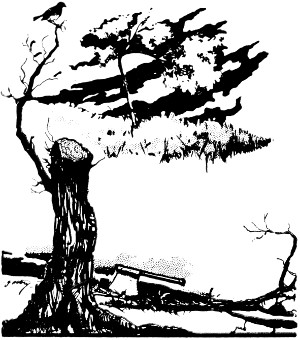
Barry Pain’s Parody of “If Winter Comes”—
IF SUMMER DON’T
Barry Pain’s skit on Mrs. Asquith’s Memoirs (“Marge Askinforit”) took the public fancy and 50,000 copies have been sold to date. Mr. Barry Pain has now turned his attention to “If Winter Comes” and has written a parody of this “best seller,” which is a scream from cover to cover.
F’cap 8vo. 1s. 6d. net.
At 1s. 6d. net, in paper.
At 2s. net, in cloth—Going Home.
T. Werner Laurie, Ltd., 30 New Bridge St., London, E.C.4.